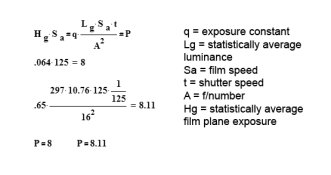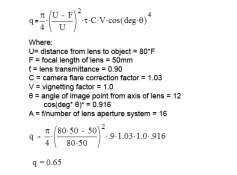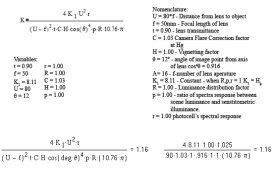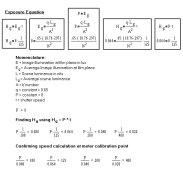Stephen Benskin
Member
On page 190 of D. Connelly's paper Calibration Levels of Films and Exposure Devices,here, there is an equation (circled) where Connelly defines a value of K as 8/0.65. What's interesting is that 8 and 0.65 are also constants: P and q respectively. That makes the equation K = P/q. This illustrates the interconnection between the different constants in the process of exposure. K is connected to the exposure meter, q to the camera exposure, and P to the film exposure. If any two constants are known, the third can be determined.
Connelly's equation has K = 12.3. According to the ISO exposure meter standard, the "ideal" value of K should equal 12.5. Contrary to what most people seem to believe, this isn't about reflectance. 12.5 isn't 12.5%, but cd/m2. If you plug 12.5 into the equation P = 8.11 and not 8. This makes a small difference in the exposure value but it helps will the math. I believe the difference comes from rounding differences. 125 film speed is rounded down from 128.
Here are the breakdowns of the constants. Notice how many of the variables are in both the q and K equations, and how the value of P is K1 in the K equation. I think this is definite evidence of the interconnection between the exposure meter, camera exposure, and exposure placement on the film. It also proves that the the value of K is not an arbitrary value chosen by exposure meter manufacturers.
P

q

K

Connelly's equation has K = 12.3. According to the ISO exposure meter standard, the "ideal" value of K should equal 12.5. Contrary to what most people seem to believe, this isn't about reflectance. 12.5 isn't 12.5%, but cd/m2. If you plug 12.5 into the equation P = 8.11 and not 8. This makes a small difference in the exposure value but it helps will the math. I believe the difference comes from rounding differences. 125 film speed is rounded down from 128.
Here are the breakdowns of the constants. Notice how many of the variables are in both the q and K equations, and how the value of P is K1 in the K equation. I think this is definite evidence of the interconnection between the exposure meter, camera exposure, and exposure placement on the film. It also proves that the the value of K is not an arbitrary value chosen by exposure meter manufacturers.
P

q

K

Last edited by a moderator:




